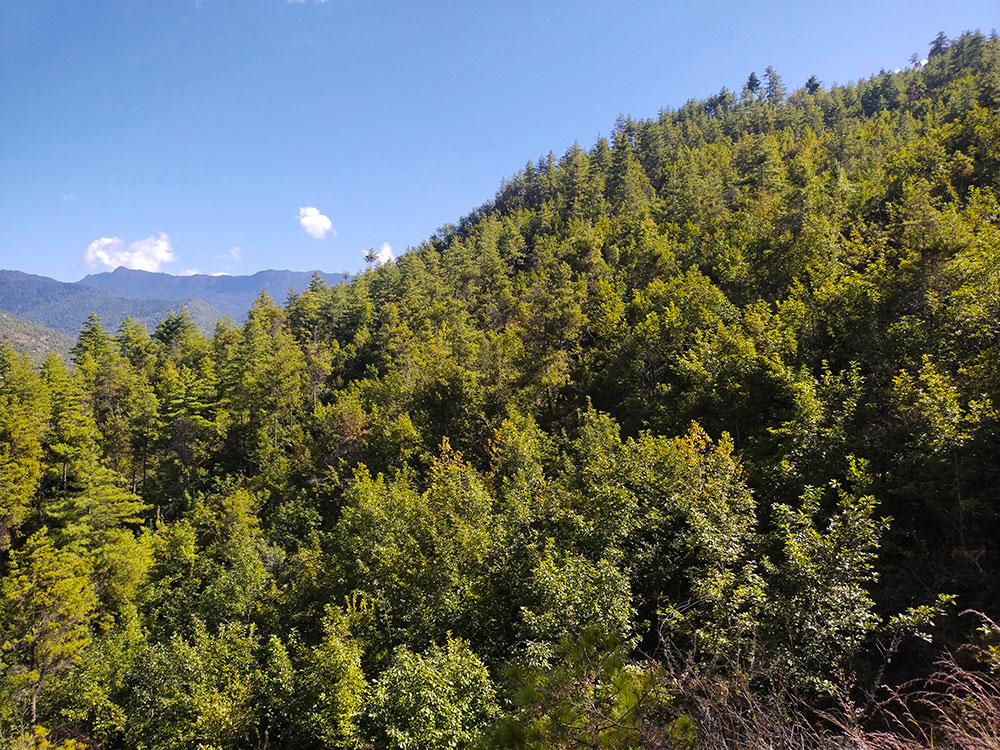YK Poudel
Bhutan has forest coverage of about 69.71 percent of the land. A recent report from the World Bank says that the country isn’t using its natural resources as much as it could.
The report suggests that Bhutan should use these resources sustainably.
The report highlights that Bhutan as the world’s first carbon-negative country removes more carbon dioxide from the atmosphere than it emits.
Bhutan has committed to staying carbon neutral, and its forests play a big role in this. With almost 69.5 percent of its land covered by forests, Bhutan’s trees absorb more carbon dioxide than the country produces.
The report suggests that Bhutan could benefit from selling emission offsets in voluntary carbon markets. This means Bhutan could make money by offering to compensate for carbon emissions elsewhere.
Even though Bhutan has a lot of forests, the country buys more wood-based products from other countries than it sells.
For example, in 2019, Bhutan imported wood-based products worth around USD 52.4 million but only exported about USD 0.9 million.
The World Bank report points out that Bhutan could invest in its wood-based manufacturing industries to make more valuable products from its forests. This could help Bhutan earn more money from the forestry sector by creating products with higher value.
The recommendation suggests adopting glue-laminated timber, also known as glulam timber technology, on a larger scale and establishing a mid-scaled production of charcoal within the country as sustainable strategies.
The report highlights that investing in glue-laminated timber could decrease the construction sector’s reliance on steel-based structures.
Additionally, a pilot glulam factory has been established in the country with assistance from Swiss company Häring AG.
According to the report, the cost of producing glulam in 2019 was reported at USD 317 per cubic metre, significantly lower than the world market prices estimated at US dollars 500 per cubic metre.
The report indicates that industries in the country currently meet their charcoal demand by importing from India, which serves as a carbon reduction agent.
Investing in domestic charcoal production could facilitate its high-value application as fuelwood. Currently, fuelwood primarily fulfils various needs of rural households, with minimal opportunity cost, especially with the achievement of electrification goals.
Investments in glulam or charcoal technology could contribute significantly to Bhutan’s goal of achieving 100 percent carbon neutrality.
According to the third national GHG inventory, this investment could potentially reduce Bhutan’s total estimated greenhouse gas (GHG) emissions by approximately 3.2 percent.
The other scenarios considered would not lead to a significant impact in terms of avoided GHG emissions.
During the first Meet the Press session, Minister of Energy and Natural Resources (MoENR), Gem Tshering, said that the ministry must prioritise investigating the domestic timber market before considering exportation.
This decision marks a shift from the initial plan to explore domestic demand before exporting.
Lyonpo Gem Tshering said, “We cannot simply let the trees rot in the forest. There is a need to carry out the thinning process. However, the process regarding the export of timber is not yet finalised. The ministry is exploring various possibilities. Nevertheless, before exporting timber, we must assess the demand for timber within the country.”
The ministry is currently assessing the feasibility of selling timber obtained from forest thinning to fulfill domestic demand.
Initially, when the forest thinning pilot project commenced last year, the ministry had contemplated exporting the extracted timber.
For instance, approximately 135 truckloads of timber are slated for extraction from forests in Thimphu as part of the forest thinning pilot project.
Furthermore, Prime Minister Tshering Tobgay said that individuals purchase numerous engineered wood products from countries such as India, Myanmar, Thailand, and China.
He said: “We possess the raw materials necessary to manufacture these products ourselves. Therefore, if we can produce engineered wood products, there is a domestic demand for them…Moreover, if we can manufacture products that meet international standards, we can even export them.”
Bhutan recorded a total of 1,008 million trees, with an estimated 523 million saplings dispersed throughout the country. This represents a notable increase of 26 percent compared to the figures reported in 2015.
The State of Forest Report 2023 reveals a growing stock of 759 million cubic metres in standing form, indicating a decrease of 20 percent since the last National Forest Inventory (NFI) conducted in 2015.


